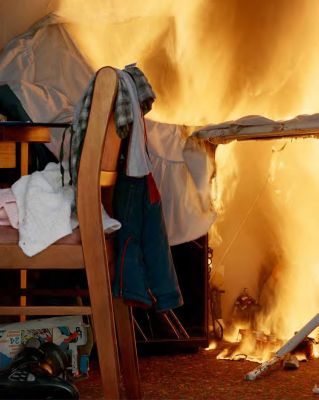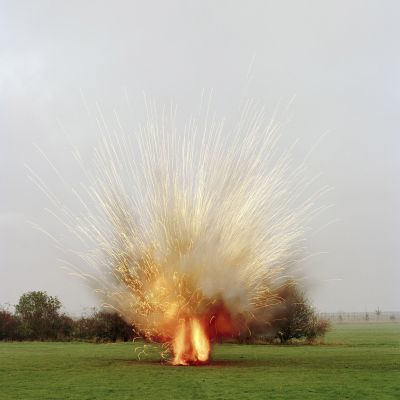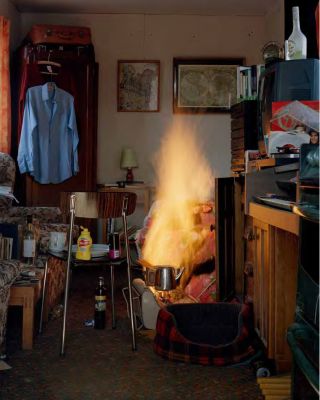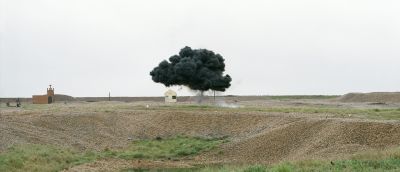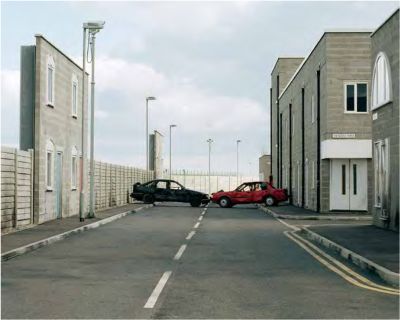Sarah Pickering: Incident Control
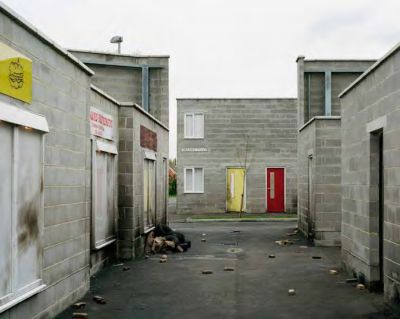
About the Exhibition
The Museum of Contemporary Photography is proud to present a monographic exhibition featuring the work of British artist Sarah Pickering. While appearing to exist between reality and illusion, Pickering’s images are actually documents of simulation. The exhibition will present a total of 36 photographs from four recent series of Pickering’s work, spanning from 2002 to the present: Explosions, Fire Scene, Incident, and Public Order.
Sarah Pickering’s photographs disturb our sense of security and illuminate the ways in which we cope with traumatic events that are beyond our control. Her pictures depict environments and events crafted specifically for simulated training to prepare police officers, firefighters, and soldiers for calamities ranging from fire and civil unrest to terrorism and war. By exposing the absurdity and controlled nature of these environments, Pickering’s images reveal our predilection to deflect fear by trying to anticipate and plan for it—and our tendency to create a story to help us process it.
Ultimately Pickering’s photographs raise questions about the efficacy of preparedness and hint at the psychological effort needed to combat and recover from trauma—the struggle to live with the anxiety that can accompany security. Pickering’s Fire Scene pictures (2007), made at the British Fire Service College, document containers outfitted as home environments and set on fire to train forensic teams and crime scene investigators. The interiors are staged as elaborate, crammed domestic spaces, deliberately heavy with a narrative: each fire has been designed according to a specific cause, such as an electric heater malfunctioning, or a glue-sniffing escapade gone wrong. The fire investigators must decipher the origin. Pickering photographs just as the fire catches, and there is a captivating beauty in the blaze and a thrilling quality in the danger and implied rescue it represents.
Like Fire Scene, Pickering’s Incident pictures (2009) are shot at the Fire Service College, but in facilities designed less for forensic analysis than for logistical and tactical training. Sparse rooms built of concrete and metal contain simple forms such as a steel framed bed, filing cabinets, chairs, and human-shaped dummies made to withstand fire for future use. The only evidence of human presence is seen in finger and foot-prints in the ash, traces of life that activate these charred spaces. Pickering takes inspiration from the grayness of the scene by pushing the contrast of her matte silver gelatin pictures to emphasize the expressive markings and their relationship to drawing.
In addition to Fire Scene and Incident, Pickering has two other bodies of work. She began the first, called Public Order (2002-05), when she was still a graduate student at the Royal College of Art in London. These photographs depict various locations used to train specialists from the British Police Service. Charged with maintaining public order, the specialist officers respond to terrorism, as well as to mayhem such as football riots and protests. The training locations are fabricated, large-scale backdrops that simulate urban environments. The largest of these, Denton, where Pickering shot most of her pictures, is a huge network of fake streets and cinder-block facades, with all of the hallmarks of a midsize British working-class city, including a football stadium, a nightclub, and a Tube station. Less realistic than a film set, Denton is staid and cartoonlike in its reductive organizational structure and general cleanliness, contradicting the reality of terrorism or a riot and their inherent disarray. Like the sets in Fire Scene, however, these locations are embedded with clues that suggest the identity of the imaginary perpetrators. Details such as bar names, graffiti, and worn furniture suggest a hardscrabble working-class environment in which the perpetrators are not inherently deviant; rather their actions are the result of circumstance. This need to humanize the trauma, to make sense of it, might promote more empathy on the part of the police and forensic trainees, or it might distance them from victims perceived as the existing in the realm of the Other.
Finally, Pickering’s Explosion photographs (2004-present) are shot at sites where fake bombs are deployed for military personnel interested in buying pyrotechnics. Manufactured by some of the same companies that make explosives for action/adventure and war films, the bombs are built for use in military training exercises. Pickering captures the explosions as they are detonated in demonstrations, isolated in a benign landscape void of people and infrastructure. Made to imitate artillery, napalm, and land mines, these explosions are controlled, and like toys or fireworks, are much smaller in scale than their real-world counterparts. The pictures Pickering makes of them are alluring. The clouds of smoke, all in different shapes and colors, hover a few feet above the ground as if a magic trick has just occurred, capturing a fleeting moment that is mysterious and beautiful, and odd in its lack of context.
The terror of security resides in the mental space between acceptance and denial, preparedness and ignorance, control and disorder. The ambiguity of fear, and the unsettling revelation that preparedness can be futile, spawns a jarring absurdity that lives at the core of Pickering’s work.
—Karen Irvine, Curator
This text was adapted from Karen Irvine’s essay “Incident Control” in the monographSarah Pickering: Explosions, Fires, and Public Order co-published by the MoCP and Aperture in 2010.
Image Gallery

